|
The Craftsmen of Rose Valley
by Bob Brooke
The Rose Valley community, located outside
Media, Pennsylvania, was the vision of architect William Lightfoot
Price, a Philadelphia free-thinking Quaker, inspired by the writings of
William Morris and the principles of the Arts and Crafts Movement.
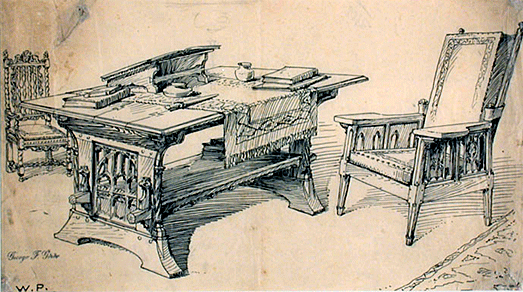
In 1901 he bought 80 acres of land and began to design and build a new
community based on the utopian English village described by Morris in
his book News from Nowhere. He planned for the inhabitants to make some
of their income from crafts they produced. Residents made some of these
while craftsmen, who rented workshops in the village, made others. Rose
Valley was also home to a metal workshop, and book bindery, the Rose
Valley Press, which printed its own magazine, The Artsman. Items made in
the community, including the furniture and pottery by William Jervis,
bore the Rose Valley seal, showing a rose with a superimposed "V"
circled with a buckled belt to symbolize friendship.
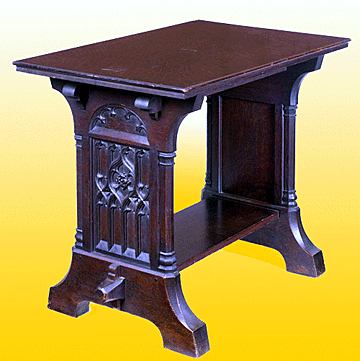 Before
he started work on Rose Valley, Price designed furniture for the houses
he built. These pieces are identical to those he had made for his
artists' community. Considered to be the most important legacy of the
Rose Valley experiment, Price designed them in a high Gothic style, with
elaborately hand-carved decoration. The furniture workshop operated from
1901 until 1906, during which time cabinetmakers produced 500 pieces. Before
he started work on Rose Valley, Price designed furniture for the houses
he built. These pieces are identical to those he had made for his
artists' community. Considered to be the most important legacy of the
Rose Valley experiment, Price designed them in a high Gothic style, with
elaborately hand-carved decoration. The furniture workshop operated from
1901 until 1906, during which time cabinetmakers produced 500 pieces.
Price didn’t advertise his furniture or publish a catalog and when
potential customers, who had seen his designs at the 1904 Louisiana
Purchase Exhibition, requested alterations, he refused them, saying the
furniture was part of his Arts and Crafts vision and couldn’t be
tailored to suit other homes. However, his furniture was expensive and
when, in 1906, it proved too great a drain on his resources, Price
closed the workshop.
Rose Valley Crafts
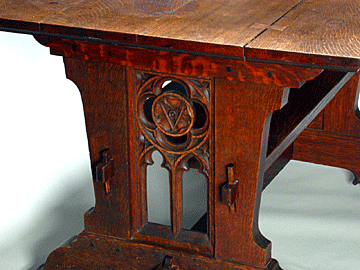 Rose
Valley had three crafts workshops that operated under the guidance of
the Rose Valley Association: Price & McLanahan’s Furniture Shop, William
P. Jervis’ Pottery Shop, and Horace Trauble’s Rose Valley Press,
printing The Artsman. Work done in these shops met the standards of the
Rose Valley Association. Rose
Valley had three crafts workshops that operated under the guidance of
the Rose Valley Association: Price & McLanahan’s Furniture Shop, William
P. Jervis’ Pottery Shop, and Horace Trauble’s Rose Valley Press,
printing The Artsman. Work done in these shops met the standards of the
Rose Valley Association.
Although many artists and craftsmen were members of the Rose Valley
Association, they didn’t necessarily make the handicrafts marked with
the Rose Valley seal. The Association intended to rent space to
non-resident artisans who they permitted to use the Rose Valley seal,
the Association’s trademark. The firm of Price and McLanahan was the
first to lease property from the association, converting the burned out
textile mill on Ridley Creek into a furniture shop. As it turned out,
the only non-residents were ceramist William Percival Jervis and most of
the woodworkers.
The Furniture Shop
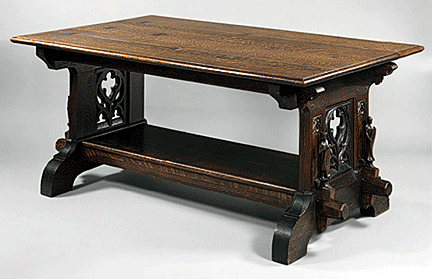 Arts
and Crafts historians believe the furniture produced at Rose Valley to
be the most important part of the Rose Valley experiment. Ironically,
Price was having furniture custom made for use in the houses he designed
before he founded Rose Valley. Those designs are indistinguishable from
the ones used at the shop in the old mill. Arts
and Crafts historians believe the furniture produced at Rose Valley to
be the most important part of the Rose Valley experiment. Ironically,
Price was having furniture custom made for use in the houses he designed
before he founded Rose Valley. Those designs are indistinguishable from
the ones used at the shop in the old mill.
Unlike the simple style of the furniture manufactured by Gustav Stickley
and Elbert Hubbard, Price’s pieces featured a highly decorative Gothic
style. Wealthy American homeowners had a taste for such dark,
elaborately carved furniture that began in the 1870s and continued
throughout the 1920’s. Like Rose Valley furniture, much of it was hand
carved. How, then, could Rose Valley pieces be so closely associated
with the ideals of the Arts and Crafts movement?
 Rose
Valley furniture had a heavy Gothic look with intricate hand carving and
thick supports. It celebrated the cabinetmaker’s craft and showcased the
skill of the woodcarver. The craftsmen in the furniture workshop gave
special care to detailing even the smallest tables and chairs. Rose
Valley furniture had a heavy Gothic look with intricate hand carving and
thick supports. It celebrated the cabinetmaker’s craft and showcased the
skill of the woodcarver. The craftsmen in the furniture workshop gave
special care to detailing even the smallest tables and chairs.
It was both useful and beautiful. But Price was also a good writer and
his articles in The Artsman stated how he thought his products embodied
the ideals of Arts and Crafts philosophy. Still, he ran into the same
problem that had stumped Morris. Arts and Crafts philosophers made a big
deal about the democratic and socialist nature of their utopian visions
but, in practice, the production of objects meeting their standard of
craftsmanship was an expensive and, therefore, an elitist reality. A
mass-produced dining table from Gustav Stickley cost $66 in 1904,
putting it well beyond the reach of most Americans; A grand, hand-carved
Rose Valley table cost $150. Even so, the Rose Valley order book and the
photographs of furniture in production suggest that Price’s furniture
shop was very busy during the few years it operated.
Jervis’ Pottery
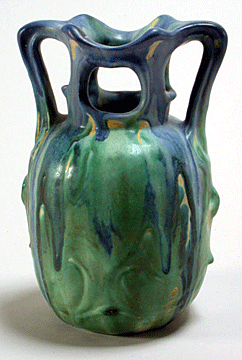 William
Percival Jervis was a nationally known master potter. Before coming to
work in Rose Valley, he managed the Avon Faience Company and worked at
the Corona Pottery. He produced The Encyclopedia of Ceramics and wrote
Rough Notes on Pottery, A Book of Pottery Marks and English Potters and
American History. William
Percival Jervis was a nationally known master potter. Before coming to
work in Rose Valley, he managed the Avon Faience Company and worked at
the Corona Pottery. He produced The Encyclopedia of Ceramics and wrote
Rough Notes on Pottery, A Book of Pottery Marks and English Potters and
American History.
He rented a studio in the Rose Valley guildhall where he created many
highly praised pieces marked with the Rose Valley seal. The fanfare that
greeted Jervis’ arrival at Rose Valley came at the height of the
popularity of art pottery. The process of making artistic pots had
become closely identified with the Arts and Crafts way of life, and
Jervis announced that his pottery would be simple as befitted the simple
life. Even though Jervis may have commuted to his studio from
Philadelphia, the idyllic environment of the Valley suited his artistic
sensibilities.
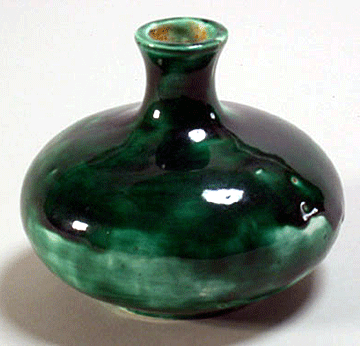 Jervis’
designed his pottery with simple lines and used green, brown, and blue
glazes that reflected the colors found around the village. Indeed, some
of his pottery designs incorporate the green fern fronds that he loved
so much. Even Louis Comfort Tiffany said that the glazes he developed at
Rose Valley were the finest he had ever seen. Jervis’
designed his pottery with simple lines and used green, brown, and blue
glazes that reflected the colors found around the village. Indeed, some
of his pottery designs incorporate the green fern fronds that he loved
so much. Even Louis Comfort Tiffany said that the glazes he developed at
Rose Valley were the finest he had ever seen.
Although Jervis produced hundreds of pieces while at Rose Valley, very
few are known today. He claimed that the Rose Valley mark would be
“impressed in the clay or printed in color.” on his pots. But, in fact,
few of his pieces bear the mark of the Rose Valley seal. And while he
may have printed labels in color, none seem to exist today. Other pieces
have raised nubs arranged in a circle. Historians believe these
represent the stamens of the Rose Valley rose. He inscribed other pieces
with “W.P. Jervis” or a handmade version of the seal. Jervis left his
pottery studio in Rose Valley in 1905.
<
Back
to More Antique Spotlights
Next Article > |
